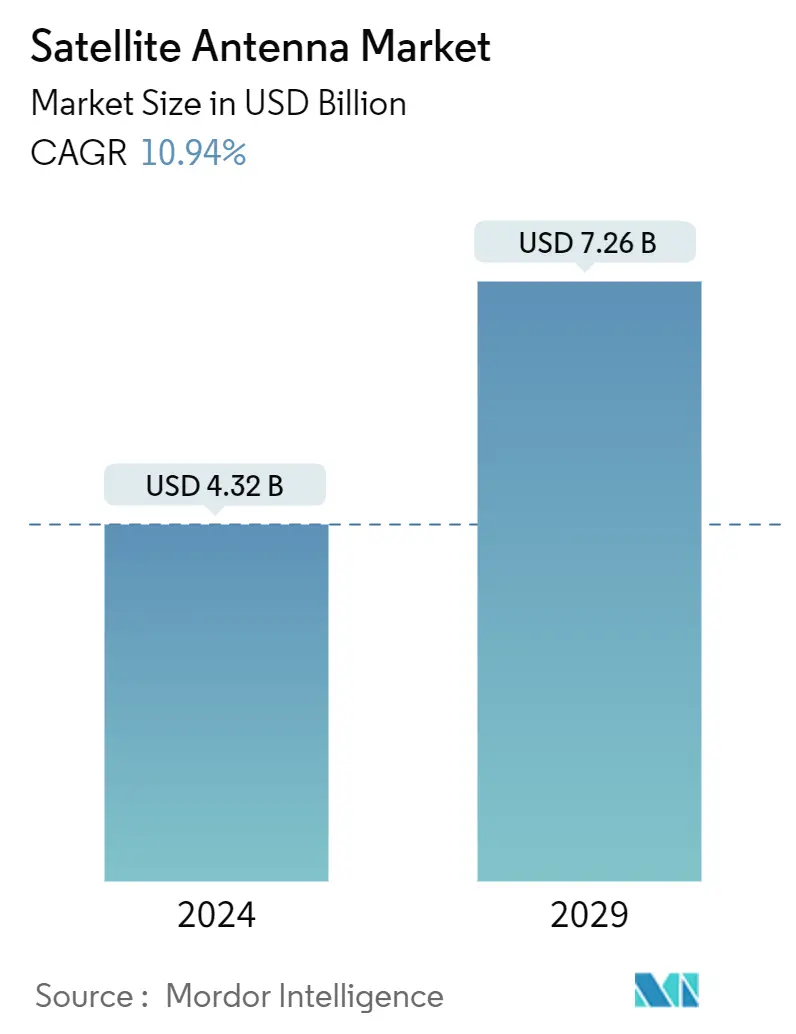Market Size of Satellite Antenna Industry

| Study Period | 2019 - 2029 |
| Market Size (2024) | USD 4.32 Billion |
| Market Size (2029) | USD 7.26 Billion |
| CAGR (2024 - 2029) | 10.94 % |
| Fastest Growing Market | Asia Pacific |
| Largest Market | North America |
Major Players
*Disclaimer: Major Players sorted in no particular order |
Satellite Antenna Market Analysis
The Satellite Antenna Market size is estimated at USD 4.32 billion in 2024, and is expected to reach USD 7.26 billion by 2029, growing at a CAGR of 10.94% during the forecast period (2024-2029).
As the demand for enhanced communication capabilities has grown significantly over the past few years in vital domains, including border security, marine interdiction, and mobile telecom, satellite antenna systems have emerged as essential solutions.
- The demand for broadband communications continues to rise and is not necessarily location-specific. This demand includes the need for connection for users functioning on ships, planes, and vehicles (including first responders) that are both fixed and active. These three distinct platforms require constant connectivity along their routes, frequently passing through unserved sections of major metropolitan cities and less heavily populated regions.
- The growing number of space exploration missions, the proliferation of small satellites, rising investments, and expanding demand for satellite-assisted military systems are facilitating the expansion of the market studied. For instance, in March 2023, funding of USD 2.5 billion was announced as part of the federal budget to support Canadian leadership in space, including USD 150 million over five years for the Lunar Exploration Accelerator Program (LEAP) to support Canada's advanced space industry and help accelerate the development of new technologies.
- Furthermore, due to the lightweight profile of the Ku band antennas, their application in space-bound projects is significantly higher than other bands. The satellite antennas deployed in space are being increasingly used for applications in telemetry, GPS (global positioning system), UHF (ultra-high frequency), FTS (flight termination system), etc.
- According to the Union of Concerned Scientists, as of April 30, 2022, the United States had 3,433 operational artificial satellites circling the Earth. It is the number of satellites a single country has to date, with China accounting for only 541. Furthermore, according to Jonathan's Space Report, an estimated 6,905 active satellites circled the Earth in 2022, an increase of 2,105 active satellites from 2021. Such a huge number of satellites is anticipated to provide opportunities for the growth of the market studied.
- Satellite antennas can get degraded or out of alignment over time, which can cause problems, including signal loss, interference, or poor performance. Regular maintenance and adjustment are required to guarantee efficient signal transmission and reception. However, maintaining satellite antennas, particularly those in geostationary orbit, may be expensive and logistically challenging, affecting market expansion. The solution to these difficulties is creating more durable and dependable antenna technology and enhancing maintenance procedures.
- Post-pandemic, several industries are investing in various strategic developments to gain market share and keep them updated with the current requirements in the market. For instance, in April 2023, the launch of the OpenEdgeTM 2500 digitizer, designed expressly to assist satellite antenna manufacturers in digitally enabling their products, was announced by Kratos Defence & Security Solutions, Inc., a technology firm specializing in defense, national security, and communications solutions. When incorporated into any antenna, the compact digitizer efficiently transforms radio frequency (RF) signals into Internet protocol (IP) data streams that may be used in contemporary software-defined communications networks.
Satellite Antenna Industry Segmentation
Satellite antennas are primarily used to provide communication paths with other satellites and Earth stations. A typical satellite antenna consists of three main components: antenna structure, beam-forming network, and feed system.
The satellite antenna market is segmented by frequency band (C Band, K/KU/KA Band, S and L Band, X Band, VHF & UHF Band), by antenna type (flat panel antenna, parabolic reflector antenna, horn antenna, fiberglass reinforced plastic antenna, iron antenna with mold stamping), by application (space, land, maritime, airborne), by geography (North America (United States, Canada), Europe (United Kingdom, Germany, France, Rest of Europe), Asia-Pacific (China, Japan, India, South Korea, Rest of Asia-Pacific), Rest of the World (Latin America, Middle East & Africa). The market sizes and forecasts are provided in terms of value in USD for all the segments.
| By Frequency Band | |
| C Band | |
| K/KU/KA Band | |
| S and L Band | |
| X Band | |
| VHF and UHF Band | |
| Other Frequency Bands |
| By Antenna Type | |
| Flat Panel Antenna | |
| Parabolic Reflector Antenna | |
| Horn Antenna | |
| Fiberglass Reinforced Plastic Antenna | |
| Iron Antenna with Mold Stamping | |
| Other Antenna Types |
| By Application | |
| Space | |
| Land | |
| Maritime | |
| Airborne |
| By Geography | |||||||
| |||||||
| |||||||
| |||||||
| Rest of the World (Latin America and Middle East and Africa) |
Satellite Antenna Market Size Summary
The satellite antenna market is poised for significant growth, driven by the increasing demand for enhanced communication capabilities across various sectors such as border security, marine interdiction, and mobile telecommunications. As the need for broadband communications rises, particularly in remote and underserved areas, satellite antennas have become essential for providing connectivity on platforms like ships, planes, and vehicles. The market is further bolstered by the proliferation of small satellites and space exploration missions, which necessitate advanced satellite-assisted military systems. The lightweight Ku band antennas are particularly favored for space-bound projects due to their versatility in applications like telemetry and GPS. However, challenges such as signal degradation and maintenance costs, especially for geostationary satellites, necessitate the development of more durable and efficient antenna technologies.
The global space industry is experiencing rapid growth, with advancements in satellite technology and the expansion of satellite communication services driving the demand for satellite antennas. The miniaturization of satellites, including CubeSats and nanosatellites, has led to a surge in demand for compact antenna solutions. Companies like SpaceX and OneWeb are developing satellite constellations to provide global broadband coverage, further fueling market expansion. In regions like the United States and Canada, satellite antennas are crucial for delivering high-speed internet to rural areas where traditional infrastructure is lacking. The market is characterized by high competition, with major players like Honeywell and Harris leading the charge. Strategic partnerships, technological innovations, and investments are expected to enhance market growth, with a focus on providing better frequency bands and advanced communication solutions.
Satellite Antenna Market Size - Table of Contents
-
1. MARKET INSIGHTS
-
1.1 Market Overview
-
1.2 Industry Attractiveness - Porter's Five Forces Analysis
-
1.2.1 Bargaining Power of Suppliers
-
1.2.2 Bargaining Power of Consumers
-
1.2.3 Threat of New Entrants
-
1.2.4 Threat of Substitutes
-
1.2.5 Intensity of Competitive Rivalry
-
-
1.3 Assessment of the Impact of COVID-19 on the Industry
-
-
2. MARKET SEGMENTATION
-
2.1 By Frequency Band
-
2.1.1 C Band
-
2.1.2 K/KU/KA Band
-
2.1.3 S and L Band
-
2.1.4 X Band
-
2.1.5 VHF and UHF Band
-
2.1.6 Other Frequency Bands
-
-
2.2 By Antenna Type
-
2.2.1 Flat Panel Antenna
-
2.2.2 Parabolic Reflector Antenna
-
2.2.3 Horn Antenna
-
2.2.4 Fiberglass Reinforced Plastic Antenna
-
2.2.5 Iron Antenna with Mold Stamping
-
2.2.6 Other Antenna Types
-
-
2.3 By Application
-
2.3.1 Space
-
2.3.2 Land
-
2.3.3 Maritime
-
2.3.4 Airborne
-
-
2.4 By Geography
-
2.4.1 North America
-
2.4.1.1 United States
-
2.4.1.2 Canada
-
-
2.4.2 Europe
-
2.4.2.1 United Kingdom
-
2.4.2.2 Germany
-
2.4.2.3 France
-
2.4.2.4 Rest of Europe
-
-
2.4.3 Asia-Pacific
-
2.4.3.1 China
-
2.4.3.2 Japan
-
2.4.3.3 India
-
2.4.3.4 South Korea
-
2.4.3.5 Rest of Asia-Pacific
-
-
2.4.4 Rest of the World (Latin America and Middle East and Africa)
-
-
Satellite Antenna Market Size FAQs
How big is the Satellite Antenna Market?
The Satellite Antenna Market size is expected to reach USD 4.32 billion in 2024 and grow at a CAGR of 10.94% to reach USD 7.26 billion by 2029.
What is the current Satellite Antenna Market size?
In 2024, the Satellite Antenna Market size is expected to reach USD 4.32 billion.

